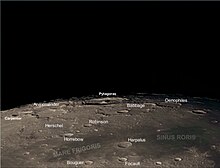From Wikipedia, the free encyclopedia
Crater on the Moon
Feature on the moon
 Harpalus crater and its vicinity
Harpalus crater and its vicinity
Harpalus
is a young
lunar
impact crater
that lies on the
Mare Frigoris
, at the eastern edge of the
Sinus Roris
. To the southeast at the edge of the
mare
is the small crater
Foucault
, and to the northwest on the opposite edge is the walled plain named
South
.
The rim of Harpalus is sharp-edged with little sign of wear or erosion. The wall is not perfectly circular, and has a few outward notches and protrusions, especially along the eastern half. It is surrounded by an outer
rampart
of ejecta, most notably towards the north, and is at the center of a small
ray system
. Due to its rays, Harpalus is mapped as part of the
Copernican System
.
[1]
The inner surface is
terraced
, and flows down to the floor. The interior wall is the least wide along the northern face, making the floor slightly offset in that direction. Near the midpoint is a system of low central ridges.
Popular culture references
[
edit
]
Harpalus was the rocket landing site in the
1950s
science fiction film
Destination Moon
. It was chosen by artist
Chesley Bonestell
as it had a relatively high latitude and the
Earth
could be realistically displayed at a low altitude during camera shots. However, the resulting clay model depicted
crazing
(net-like cracks) across the crater floor, an addition to which Bonestell objected.
Satellite craters
[
edit
]
By convention, these features are identified on lunar maps by placing the letter on the side of the crater midpoint that is closest to Harpalus.
| Harpalus
|
Latitude
|
Longitude
|
Diameter
|
| B
|
56.2° N
|
43.7° W
|
8 km
|
| C
|
55.5° N
|
45.1° W
|
10 km
|
| E
|
52.7° N
|
50.8° W
|
7 km
|
| G
|
53.6° N
|
52.3° W
|
11 km
|
| H
|
53.8° N
|
53.2° W
|
8 km
|
| S
|
51.4° N
|
49.9° W
|
5 km
|
| T
|
50.0° N
|
49.4° W
|
4 km
|
References
[
edit
]
- ^
The geologic history of the Moon, 1987,
Wilhelms, Don E.
; with sections by McCauley, John F.; Trask, Newell J.
USGS
Professional Paper: 1348. Plate 11: Copernican System (
online
)
- Andersson, L. E.;
Whitaker, E. A.
(1982).
NASA
Catalogue of Lunar Nomenclature
. NASA RP-1097.
- Blue, Jennifer (July 25, 2007).
"Gazetteer of Planetary Nomenclature"
.
USGS
. Retrieved
2007-08-05
.
- Bussey, B.
;
Spudis, P.
(2004).
The Clementine Atlas of the Moon
. New York:
Cambridge University Press
.
ISBN
978-0-521-81528-4
.
- Cocks, Elijah E.; Cocks, Josiah C. (1995).
Who's Who on the Moon: A Biographical Dictionary of Lunar Nomenclature
. Tudor Publishers.
ISBN
978-0-936389-27-1
.
- McDowell, Jonathan (July 15, 2007).
"Lunar Nomenclature"
.
Jonathan's Space Report
. Retrieved
2007-10-24
.
- Menzel, D. H.; Minnaert, M.; Levin, B.; Dollfus, A.; Bell, B. (1971). "Report on Lunar Nomenclature by the Working Group of Commission 17 of the IAU".
Space Science Reviews
.
12
(2): 136?186.
Bibcode
:
1971SSRv...12..136M
.
doi
:
10.1007/BF00171763
.
S2CID
122125855
.
- Moore, Patrick
(2001).
On the Moon
.
Sterling Publishing Co.
ISBN
978-0-304-35469-6
.
- Price, Fred W. (1988).
The Moon Observer's Handbook
. Cambridge University Press.
ISBN
978-0-521-33500-3
.
- Rukl, Antonin
(1990).
Atlas of the Moon
.
Kalmbach Books
.
ISBN
978-0-913135-17-4
.
- Webb, Rev. T. W.
(1962).
Celestial Objects for Common Telescopes
(6th revised ed.). Dover.
ISBN
978-0-486-20917-3
.
- Whitaker, Ewen A.
(1999).
Mapping and Naming the Moon
. Cambridge University Press.
ISBN
978-0-521-62248-6
.
- Wlasuk, Peter T. (2000).
Observing the Moon
. Springer.
ISBN
978-1-85233-193-1
.